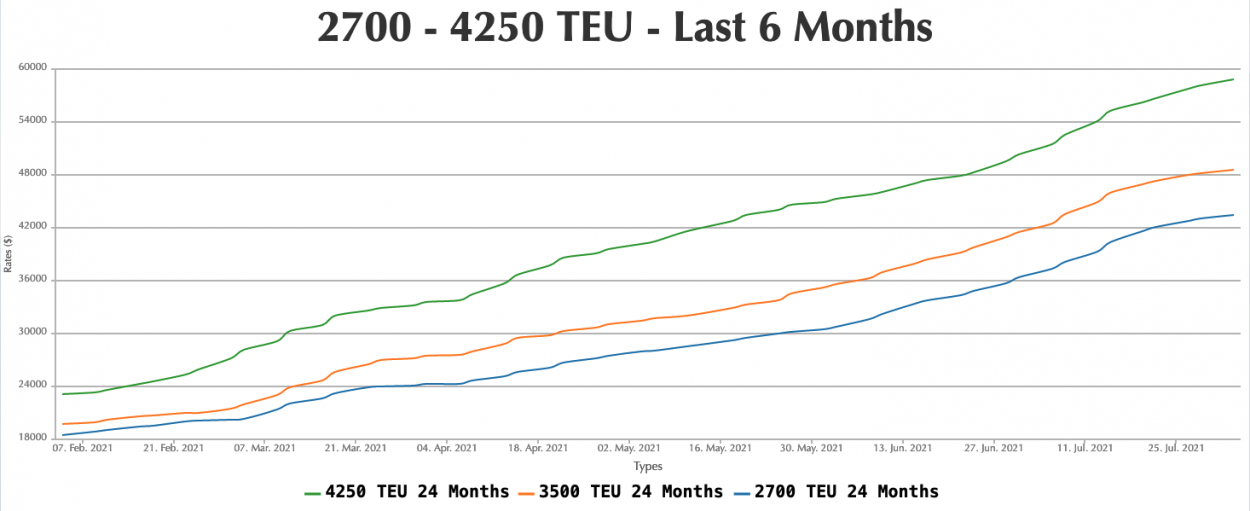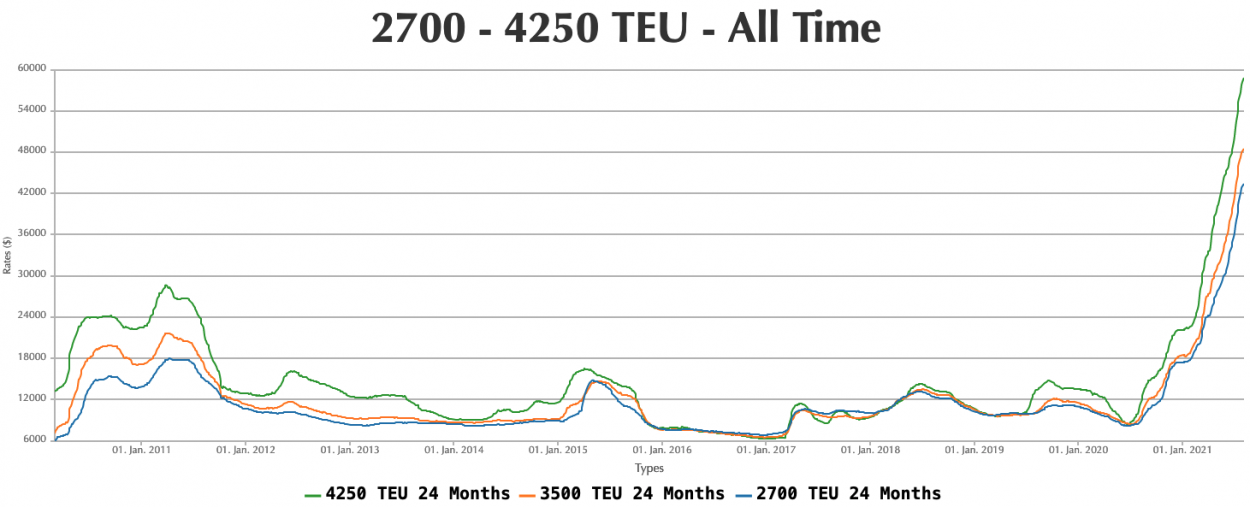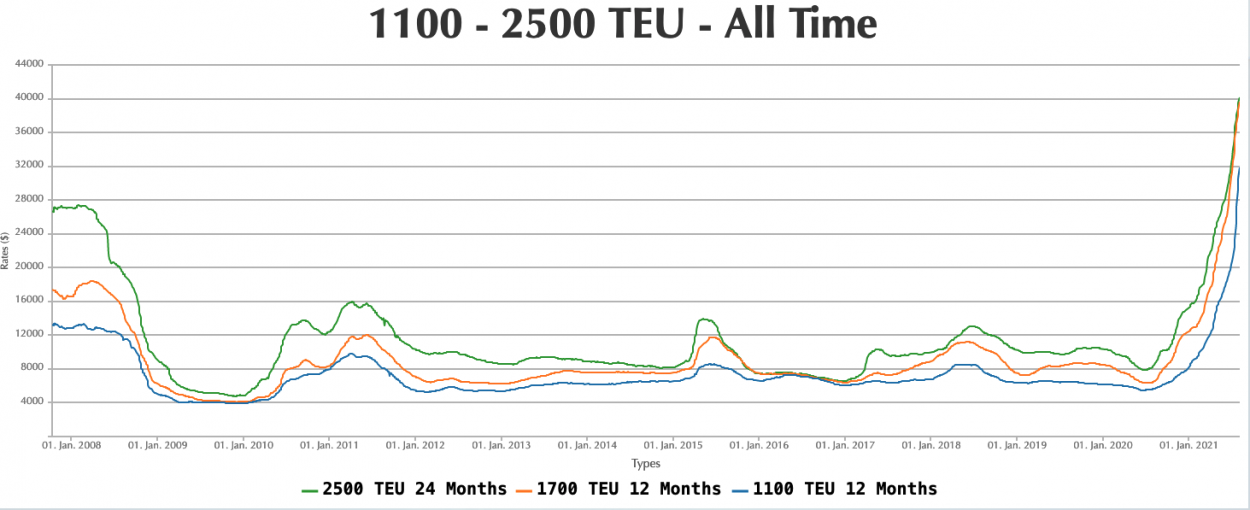Why is it that in a very short time, the prices of containers between China and Canada have experienced an exponential rise in logistics prices? We asked our Quebec clients, to verify just how big this increase actually was… According to most of them, a 52ft container went from under $3,800 CAD up to $20,000 CAD!
At first, we were skeptical. We then proceeded to check ourselves the various index available… and, oh surprise, we found that this increase is very real. But, it is also “trendy” which means, that we risk finding ourselves with these same prices for a good chunk of time, before the pressures that lead to this situation, decrease bit by bit.

We can see from the graph above, that in the last 6 months, the prices have increased by at least 100%, HOWEVER…

If we look back a little more, we can observe an increase in almost 800% (which matches the responses we got from our affected customers!)
But, even more interesting, if we try to see a cyclical behavior, we can see that, unfortunately, we are being faced with an unprecedented situation that could continue for some time. Because the prices that containers reach have never seen such an increase, at least since 2008 according to NewConTex.

So, what are the reasons behind this trend?
According to the “Weekly Container Report” of The Hellenic Shipping news, there are 7 main reasons that got us in this unfortunate risk position. (Free translation, the link to the full article in English is provided at the end of this collaboration)
The COVID-19 pandemic
The shipping industry has been one of the sectors most affected by the Covid-19 pandemic. First, all major countries who are oil producers, have significantly reduced their production due to the pandemic, which created an imbalance between supply and demand, leading to price pressures.
Growing demand for goods
Second, the growing demand for goods and the shortage of empty containers are another reason why distribution is out of whack.
This results in such a significant increase in freight costs.
When the pandemic interrupted production in the first half of 2020, companies had to scale up their manufacturing to meet the dizzying demands. In addition, with the restrictions related to the pandemic disrupting the aviation industry, tremendous pressure has accrued on sea transport for the delivery of goods.
That in turn had a ripple effect on the turnaround time of containers.
Continued dependence on split shipments
E-commerce retailers have been using split shipping widely for many reasons.
First of all, the goods must be selected from stocks of different places.
Second, dividing the shipment into sub-shipments, especially if it belongs to different categories, can help to improve the delivery speed.
Third, as a single truck or plane does not have enough room for an entire shipment, it may be necessary to divide it into individual boxes and transport it separately.
The expeditions, or fractions occur on a large scale when shipping goods internationally.
Brexit
Eh yes! Brexit increases freight rates for goods to and from the UK.
In addition to the pandemic, Brexit has caused many cross-border frictions; due to the cost of shipping goods, to and from the country increasing exorbitantly.
With Brexit, the UK had to give up.
Due to several grants available under the aegis of the EU, the transfer of goods to and from the UK is now being treated as intercontinental expeditions. Combined with the pandemic which complicates supply chains, freight rates for goods to and from the UK have already quadrupled.
Import demand from China
Besides the above mentioned reasons, another major reason for this surge in price is the huge demand for containers in China.
China is the biggest manufacturer in the world, western countries such as the United States and Europe hugely depend on China for various products. Therefore, countries are prepared to double or triple the price of purchased goods from China.
Thus, although the availability of containers has decreased considerably because of the pandemic, there is a huge demand for containers in China, and the Freight rates there are also considerably high. This also has contributed significantly to the rise in logistics prices.
Other factors in the current scenario (Communications and front common carriers)
Besides the aforementioned points, there are a few less known contributors to high freight rates.
Communication problems resulting in last-minute hijackings or cancellations, are currently one of the reasons for the explosion of freight prices. In addition, the transport sector, like other industries, tends to have ripple effects when companies take important actions.
So, when the market leaders (the biggest carriers) decide to increase their costs to recover losses, overall market prices are also inflated.
What to do to counter rising freight rates?
There are several things the industry can do to curb hikes in freight rates. For example, changing the day or time of shipping and transport during “quieter” days such as Mondays or Fridays; instead Thursdays, which are generally referred to as the busiest, can reduce transport costs by 15 to 20% per year.
Businesses can plan ahead for consolidation and shipping multiple deliveries at the same time instead of individual deliveries. This may help businesses take advantage of discounts and other incentives from shipping companies on bulk shipments.
Overpacking may increase overall shipping costs, in addition to damaging the global ecosystem. Therefore, companies should seek to avoid it. In addition, small businesses should seek out the services of integrated transport partners for shipments, as outsourcing can help them focus on their core business.
Obviously, looking for alternatives, in terms of “local” suppliers or at least with “continentals” can also be a game-changer.
If your production is labor intensive, solutions of repatriation of your production (Reshoring) such as; subcontracting, Industrial establishment, or manufacturing contracts, among others, at Canada, the United States or Mexico may prove to be a long-term solution.
One that could be profitable and reduce the risks associated with its fluctuations over which most companies have no control.
Sources
Weekly Container Report, “Why freight rates are high right now and how shippers can adapt?.” Helenic Shipping News, August 6th, 2021, click here access source.
NewConTex, Vereinigung Hamburger Schiffsmakler und Schiffsagenten e.V., August 6th, 2021, click here to access source.

2 comments
Comments are closed.